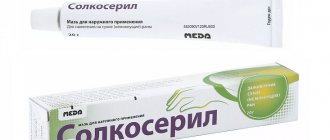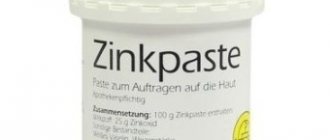From this article you will learn:
- indications for use,
- instructions for use in the oral cavity,
- composition analysis, analogues, price 2021.
The article was written by a dentist with more than 19 years of experience.
Solcoseryl dental adhesive paste is a dental preparation based on deproteinized dialysate from the blood of calves, which is intended to accelerate the healing of ulcers, erosions and traumatic injuries of the oral mucosa. The drug can only be used on moist mucous membranes and, accordingly, it is not suitable for the treatment of wounds and skin lesions. In the latter cases, you should use Solcoseryl forms - in the form of a gel or ointment.
The drug is produced by an international pharmaceutical company and is registered as a “medicinal product”. In addition, it has no age restrictions and is available without a prescription. Solcoseryl dental paste has the appearance of a pale yellow homogeneous granular mass. If you squeeze the paste out of the tube, you will notice that it has a slightly dry consistency. Despite this, the paste is easily distributed and firmly fixed on the oral mucosa, while also performing the function of a protective bandage. The latter is very important, because if there are erosions on the mucous membrane, eating will be very painful.
Solcoseryl dental paste: photo of packaging
Indications for use –
- for stomatitis – to accelerate the healing of ulcers and relieve pain (Fig. 3),
- after surgical operations in the oral cavity,
- bedsores under dentures
- for the treatment of jamming in the corners of the mouth,
- to accelerate the healing of the socket of an extracted tooth with alveolitis (Fig. 4).
This article was written by a dental surgeon, and in some cases that require clarification, the optimal solution for these indications will still be not adhesive dental paste, but Solcoseryl in gel form. In our opinion, for stomatitis, the paste will be optimal only in the presence of deep ulcerations, and for superficial erosions it will be better to use a gel. The same applies to the treatment of bedsores under dentures. For a detailed description of the use of the drug, read below.
Solcoseryl dental paste – price, composition and analogues
The cost of this drug has increased significantly by the end of 2021 and, frankly, the increase is absolutely inadequate. As a practicing doctor, I don’t quite understand how a drug with the simplest composition can be so expensive. For Solcoseryl dental adhesive paste, the price in Russian pharmacies will be on average from 1600 to 2000 rubles, although in neighboring Poland its price is only 800 rubles (prices are indicated for October 2021).
Composition of the drug: (the paste is available in aluminum tubes of only 5 g).
| 1 g of paste contains - → deproteinized dialysate from the blood of healthy dairy calves, → polidocanol 600. | 2.125 mg 10 mg |
| Excipients - carboxymethylcellulose, peppermint oil, menthol, gelatin, pectin, liquid paraffin, polyethylene 350000, preservatives - methyl parahydroxybenzoate (E218) and propyl parahydroxybenzoate (E216), as well as a residual amount of parahydroxybenzoic acid (E 210). |
Solcoseryl dental paste: official instructions ()
Composition analysis - the main component of the drug Solcoseryl Denta is deproteinized (devoid of proteins) dialysate from the blood of dairy calves. The dialysate contains a large number of low molecular weight organic compounds - amino acids, oligopeptides and glycolipids, nucleosides, etc., which significantly accelerate the healing processes of damaged tissues. Polidocanol-600 has an analgesic effect, which is felt within 2-3 minutes after applying the paste and lasts about 3-5 hours).
Paying attention to the auxiliary components, it must be said that carboxymethylcellulose, gelatin, pectin, liquid paraffin and polyethylene are the basis of the paste, and these components allow it to adhere well to the moist mucous membrane of the oral cavity and not be washed off with saliva. People with allergies to parabens (a certain type of preservative) should pay attention to the small content of parahydroxybenzoic acid.
Cheaper analogues -
Today, Solcoseryl dental adhesive paste has no direct analogues. There are drugs with a similar effect, but a completely different composition. For example, to accelerate the regeneration of the oral mucosa, gum gels containing hyaluronic acid are suitable for you:
- Curasept “ADS 350 Regenerative” gel is a very interesting oral gel from the Swiss. Due to the content of 0.5% chlorhexidine, the gel has an antiseptic effect, and thanks to hyaluronic acid, it has a wound healing effect. This gel also contains the PVP-VA complex, which forms a protective film on wound surfaces and ulcers, accelerating their healing. The price for Curasept ADS 350 Regenerative will be about 650 rubles (for a 30 ml tube), but be careful when purchasing, because in the Curasept line there is a gel with a similar name and without hyaluronic acid.
- Oral gel "GengiGel" (GengiGel) is a gel for the mucous membrane of the gums and oral cavity, which contains 0.2% hyaluronic acid, as well as xylitol. We have already said above that hyaluronic acid has a wound-healing effect. Unfortunately, this drug costs much more than the previous one, and its concentration of hyaluronic acid is much lower.
Nosological classification (ICD-10)
- K05.0 Acute gingivitis
- K05.1 Chronic gingivitis
- K05.3 Chronic periodontitis
- K05.6 Periodontal disease, unspecified
- K06 Other changes in the gingiva and edentulous alveolar margin
- K12 Stomatitis and related lesions
- K12.0 Recurrent oral aphthae
- K13.0 Diseases of the lips
- K13.7 Other and unspecified lesions of the oral mucosa
- Z96.5 Presence of dental and jaw root implants
- Z97.2 Presence of dental prosthetic device (complete) (partial)
Solcoseryl dental adhesive paste - instructions for use
For Solcoseryl dental adhesive paste, the instructions for use contain information that the paste can be used 3-5 times a day. The effective analgesic effect of the paste develops not only due to the content of polidocanol-600, but also because the paste applied to the surface of an ulcer or wound surface forms a protective therapeutic dressing that protects the damaged oral mucosa from the effects of mechanical, chemical and thermal irritants.
Solcoseryl dental paste should be applied directly to the wound surface in a thin layer (without rubbing). This can be done either with a medical spatula or with a regular finger. Before applying the paste, it is very important to first dry the mucous membrane at the application site using a dry gauze swab. After blotting the mucous membrane with a swab, squeeze the paste onto your index finger and apply it to the damaged area of the mucous membrane (24stoma.ru).
It is most convenient to do this with your finger, because... in this case, you will distribute the paste faster and better over the surface of the mucous membrane. You can also use a cotton swab, but in this case it will be a little worse to form a tight protective bandage. After applying the paste, it is necessary to moisten it with saliva, which will allow the paste to swell and finally adhere to the mucous membrane.
The length of time the medicinal paste bandage remains on the mucous membrane may vary. For example, on a low-moving mucous membrane, the bandage will last longer, and on highly mobile areas of the mucous membrane, the fixation will always be somewhat worse, which, in principle, then allows us to consider replacing the adhesive paste with Solcoseryl gel form.
Brief application diagram –
- eating,
- teeth cleaning,
- rinsing your mouth with an antiseptic,
- apply Solcoseryl paste,
- Do not eat or rinse your mouth for 2-3 hours (you can drink).
Features of use for stomatitis, alveolitis -
Solcoseryl adhesive paste should not be used in the acute period of inflammation, because There are no antiseptics or antibiotics among the paste components. Therefore, if we are talking about infectious processes in the oral cavity, the use of paste is possible only after the acute period of inflammation has subsided, and only after that can the use of agents that accelerate healing be started.
1) Erosion and ulcers due to stomatitis - before applying the paste, it is advisable to always treat the oral mucosa with an antiseptic. For herpetic stomatitis, it is best to use a miramistin solution, and for aphthous stomatitis or damage to the mucous membrane after tooth extraction/surgery, use a chlorhexidine solution. In this case, miramistin can be used in a spray format, and chlorhexidine should be used to rinse the mouth for 1 minute.
It is advisable to use the antiseptic 2-3 times a day. You can read the features of using these antiseptic solutions in the oral cavity using the links below. Once again, we would like to draw your attention to the fact that Miramistin will be the best choice only for infectious processes of viral origin; in all other cases, it is better to use chlorhexidine.
→ regimen for the use of Chlorhexidine, → regimen for the use of Miramistin.
2) Application for alveolitis - solcoseryl in the form of dental paste is an excellent remedy for the treatment of alveolitis in the socket of an extracted tooth. The use of the paste is again indicated not in the acute period of inflammation, but only after the acute symptoms have subsided. At the first stage of treatment, removal of a necrotic blood clot from the hole is indicated (which only a dentist can do) - filling the hole, for example, with iodoform turunda.
But after the inflammation subsides, it is already possible to add adhesive paste into the hole. It is difficult to do this at home, because... in the depths of the hole that is not filled with a blood clot, food debris and bacteria are always present. And before adding the paste, you first need to rinse the well with a stream of antiseptic (for example, chlorhexidine) from a syringe, then dry it inside with a dry gauze swab to remove excess liquid, and only then fill it to the top with paste.
Applying the paste into the hole quickly relieves pain, and after about 5 minutes relief comes. But if you apply the paste into an inflamed hole, or in the depths of which there are food remains, this can provoke the development of inflammation and lead to suppuration.
3) Bedsores under dentures – one of the indications for use of Solcoseryl in the form of dental paste is bedsores under dentures. The latter can occur, for example, when you have made a new removable denture or under old dentures, when they no longer correspond to the tissues of the prosthetic bed. In the latter case, the prosthesis needs to be changed, and Solcoseryl will not be able to help you with anything, because The problem here is the old prosthesis.
But during the period of adaptation to a new prosthesis, Solcoseryl can actually be used to accelerate the epithelization of damaged mucosa and relieve pain. However, this does not mean that you should not contact your prosthetist for removable denture adjustments. Usually 2-3 corrections are required before the new prosthesis stops rubbing the mucous membrane. And, by the way, for bedsores under a prosthesis, it is better to use not adhesive paste, but Solcoseryl in gel form.
Prevention of oral diseases
The best option is to visit the dentist at least twice a year. This way you will save your health and finances. Be sure to have your mouth professionally cleaned, this will help to efficiently remove all accumulated plaque and hard deposits. The following procedures are recommended for gum health:
- Massage your gums at home, this can be done with your fingers or a soft toothbrush.
- Beware of hot foods to avoid burns.
- Be sure to wash your hands several times a day, especially after going outside, to reduce the risk of stomatitis.
- Use mouthwash.
- We advise you to purchase an irrigator; this device significantly improves blood circulation in soft tissues.
Solcoseryl dental adhesive paste: reviews
Solcoseryl paste will have a pronounced effect and accelerate the healing of wounds, erosions and ulcers, provided that they are not related to tumor-like lesions. The benefits of the drug are undeniable if you use it in accordance with these instructions. The form of Solcoseryl in the form of a dental adhesive paste is especially convenient if you need the drug to also act as a protective medical dressing (for example, after surgical interventions).
In many other cases (for stomatitis, for the treatment of bedsores under dentures), it is actually more convenient to use Solcoseryl not in the form of a paste, but in the form of a gel. The latter is also cheaper, and the volume of the tube is 4 times larger. But the paste is most convenient for the treatment of alveolitis (to accelerate the epithelization of the “empty socket” and relieve pain), use after surgical operations in the oral cavity, and especially for the treatment of deep ulcers.
Once again, we draw your attention to the fact that long-term non-healing ulcers can be a symptom of tumor growth. And if you have a history of such an ulcer or if there is no effect from using Solcoseryl, you should definitely consult a dental surgeon for advice.
Indications
For dental purposes, this medication is prescribed in the following cases:
- Burns of the mucous membrane.
- Mechanical damage to the gums.
- After tooth extraction.
- Stomatitis.
- Pimples on the gums.
Among the contraindications, the only contraindications can be noted: individual intolerance to the active substances. It is recommended to use only as prescribed by a doctor.
Please note that Solcoseryl is powerless as an independent treatment. The drug does not have antimicrobial properties, so before using the product it is necessary to disinfect the gum area with an antiseptic.
Contraindications –
The only contraindication is hypersensitivity to one of the components of the drug. Solcoseryl "Denta" is not contraindicated during pregnancy and breastfeeding. It should be used with caution only if you have severe allergic reactions. The drug contains a residual amount of parahydroxybenzoic acid (E 210), which is important to take into account in patients with allergic reactions to this component.
Allergic reactions usually develop in the form of slight swelling at the site of application of the drug. In this case, you must stop using the drug and also take an antihistamine tablet. Also, an allergic reaction may be indicated by a burning sensation at the site of application of the drug. Moreover, a slight burning sensation (which goes away almost immediately after application) does not require discontinuation of the drug. The latter is necessary only if the burning sensation is permanent.
Special instructions -
- The drug is safe for use in children, including infants.
- Solcoseryl dental adhesive paste cannot be applied to an infected wound, because it does not contain antimicrobial components.
- Before applying the paste, always treat the application area with an antiseptic.
- If fever appears, as well as redness, pain and swelling in the area of the mucous membrane near the site of application of Solcoseryl, or if discharge appears from the wound, you should consult a doctor.
- If, when using the drug, the ulcer does not heal within 10 days, you should also consult a doctor, because this may indicate oncology. We hope that our article on the topic: Solcoseryl dental adhesive paste instructions - turned out to be useful to you!
Sources:
1. Dental education of the author of the article, 2. Personal experience as a maxillofacial surgeon, dental surgeon, 3. Official website of the manufacturer – https://solcolife.ru/, 4. “Outpatient surgical dentistry” (Bezrukov V.), 5 . "Therapeutic dentistry. Textbook" (Borovsky E.).
Solcoseryl ointment as a face mask
Cosmetologists claim that the use of Solcoseryl in the early stages of age-related changes allows you to maintain youthful skin. Timely start of use can replace expensive laser rejuvenation in the salon. First of all, Solcoseryl allows you to get rid of wrinkles and prevent their earlier appearance. The ointment is capable of:
- provide adequate nutrition to the facial skin;
- get rid of acne;
- relieve inflammation;
- improve complexion;
- tighten the oval;
- get rid of wrinkles.
The expected effects are possible due to the fact that using a mask allows you to saturate tissues and cells with oxygen and accelerate regeneration. Thanks to the application of the cream, collagen, which is responsible for skin elasticity, begins to be actively produced. The more collagen produced, the fewer wrinkles your skin will have. It is like a support for a heavy skin sheet, preventing its individual areas from falling through, preventing the formation of wrinkles.




